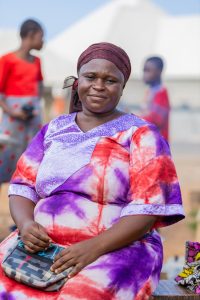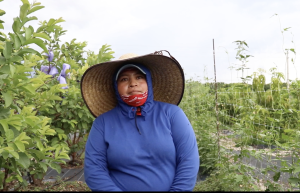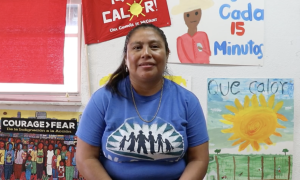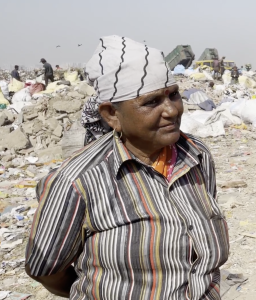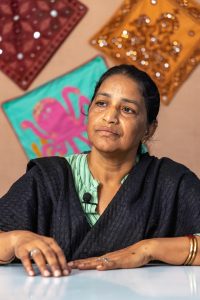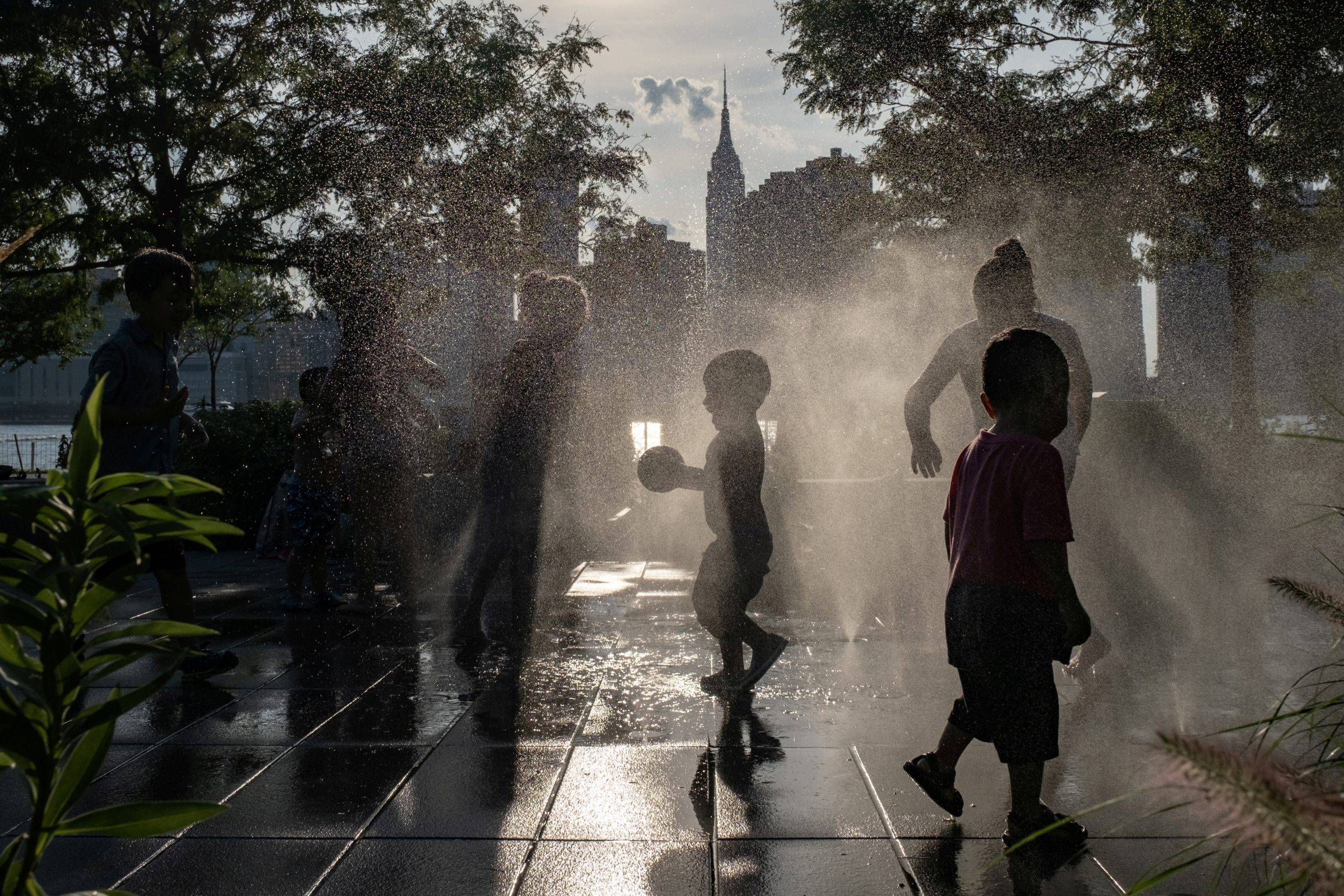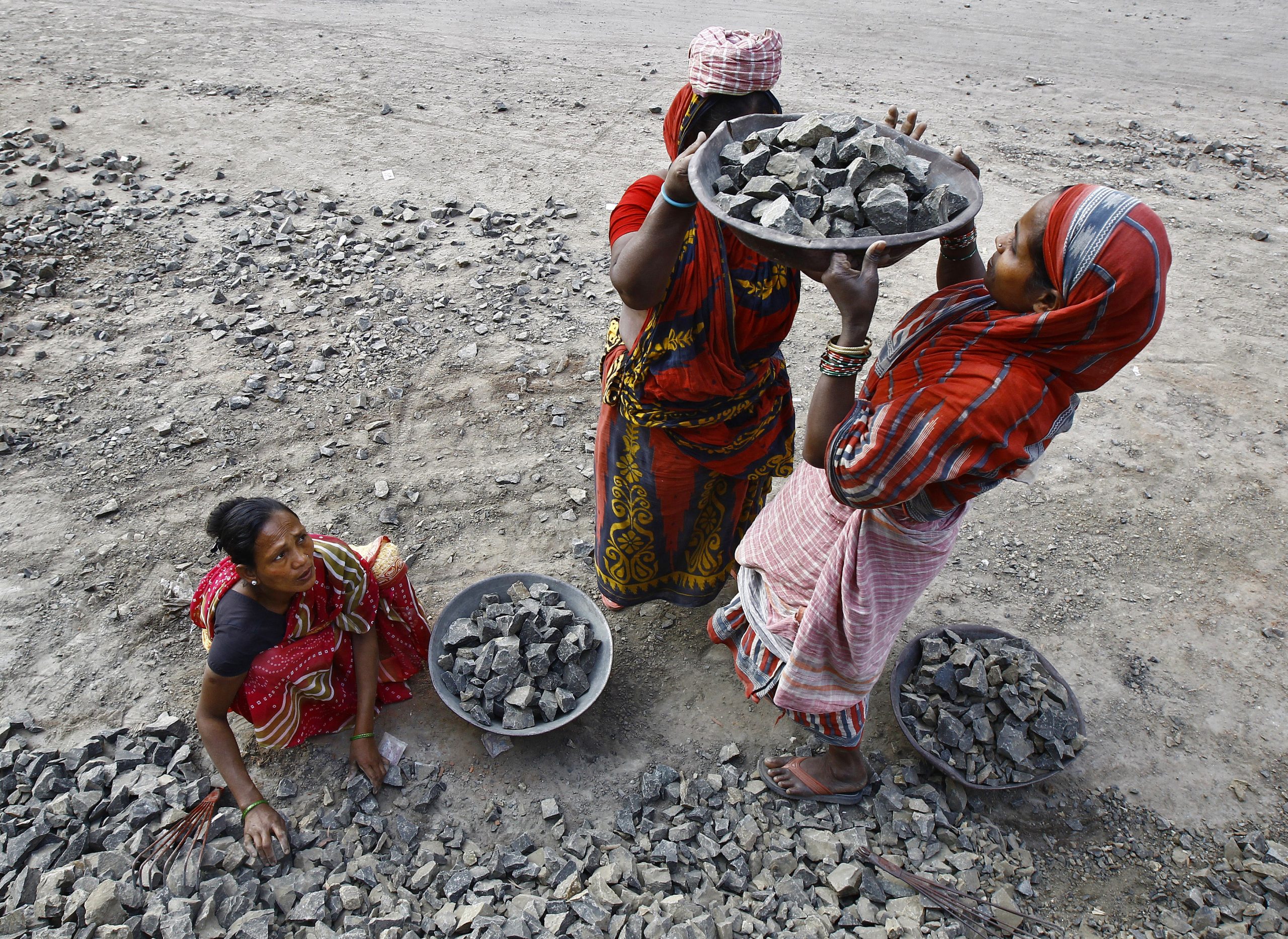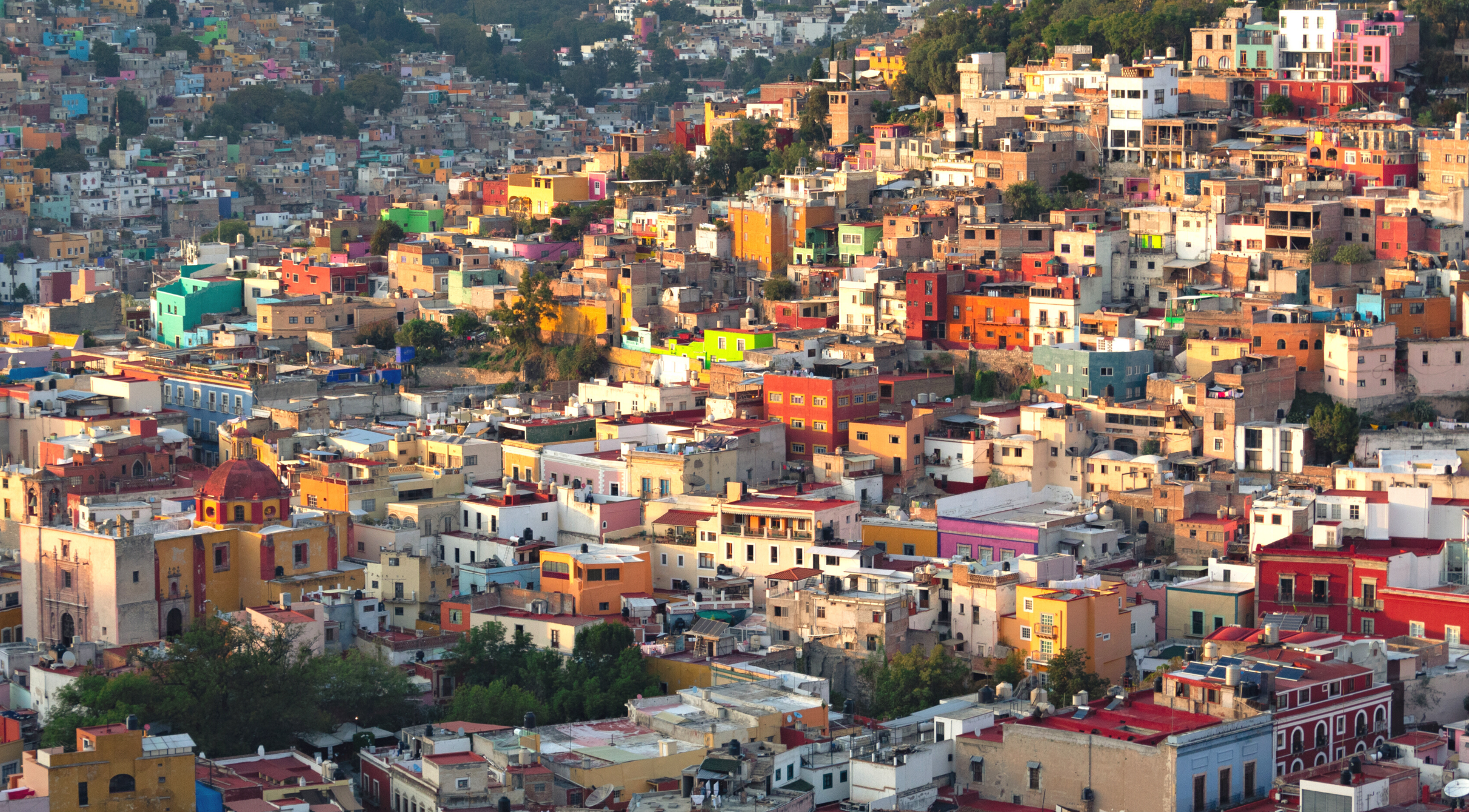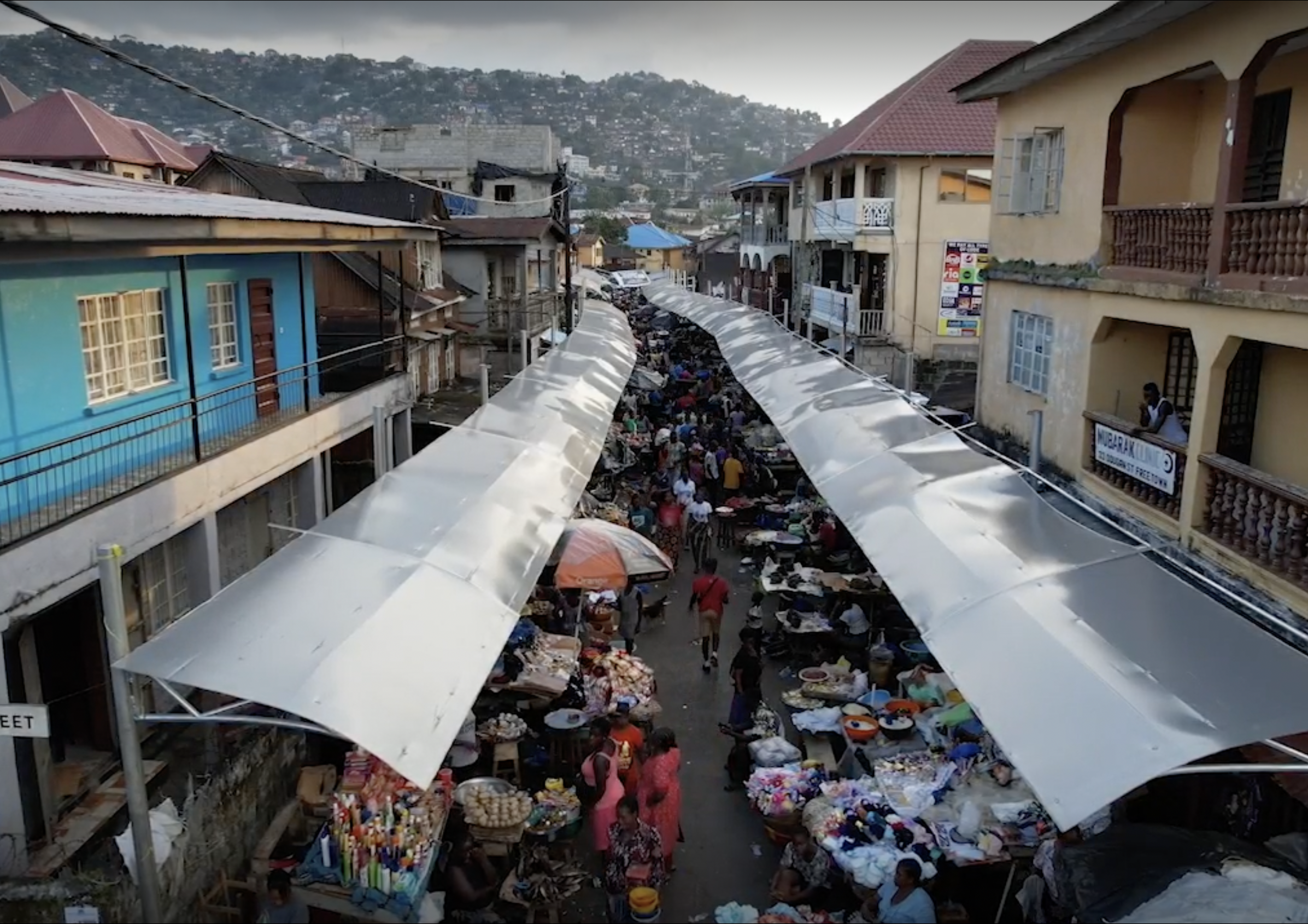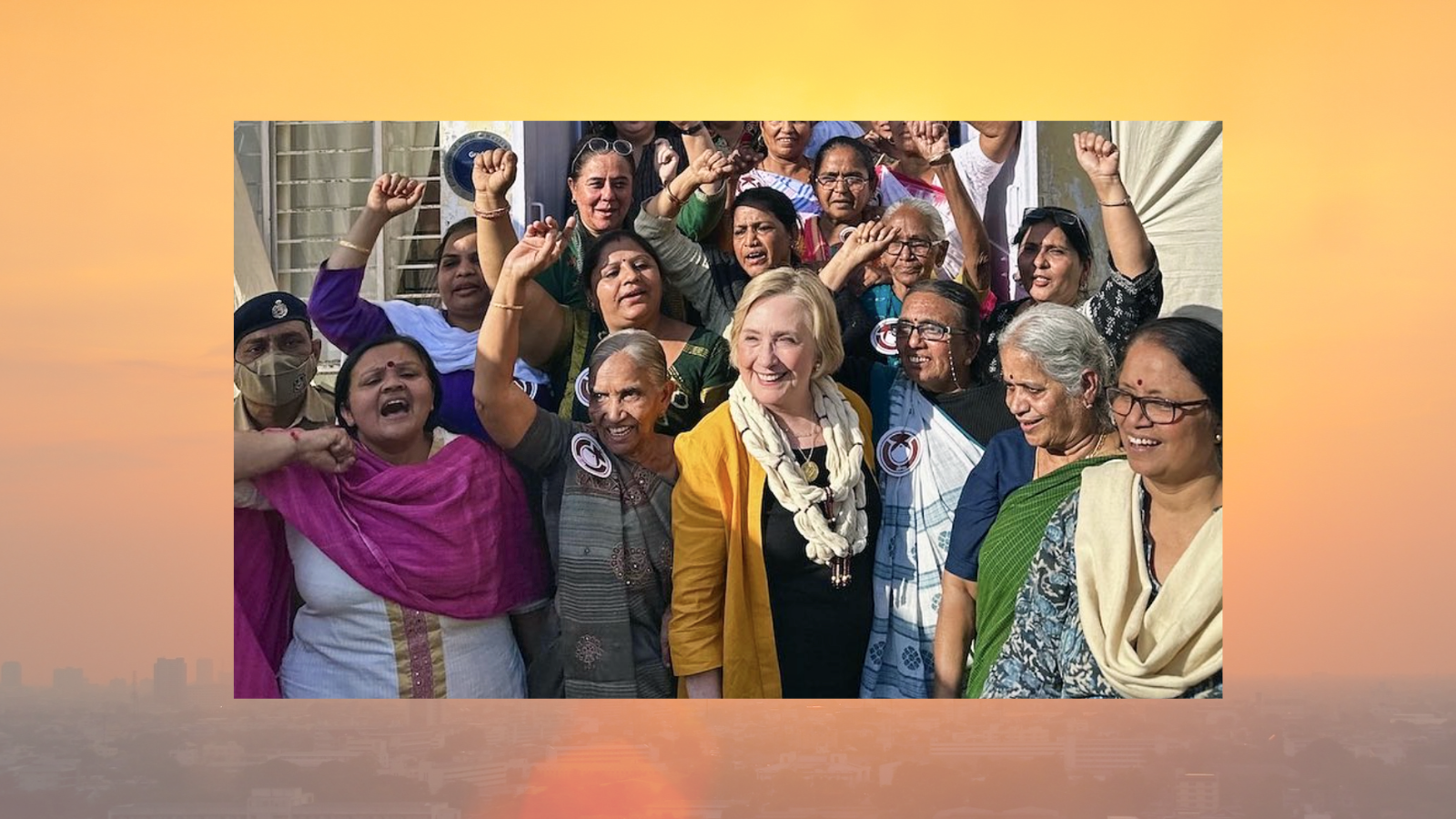Extreme heat exposes stark gender inequalities
Extreme heat affects us all, but it does not affect us equally. It’s becoming painfully clear that some are more exposed to its devastating impacts than others. One of those groups is women and girls.
Women face structural, systemic barriers, which are now being exacerbated by heat. From earning less income to their lower labor force participation, women are financially and economically disadvantaged. As a consequence, they are more vulnerable to economic losses when rising temperatures make it physically difficult—if not impossible—to work.
This new research examines the profound and unequal impact of heat on women’s unpaid domestic labor, paid employment, and health in India, Nigeria, and the United States—examining current and projected 2050 conditions. Drawing on original research on socioeconomic variables such as population, employment, health, and economic activity, and deploying best-in-class climate models, it builds an understanding of this critical issue.
Beyond the numbers, we share the firsthand experiences of women across these three countries to unveil the very human cost of extreme heat—paving the way for gender-informed interventions, investments, policies, and research.
Assessing the burdens of heat on women enables and informs solutions
Key findings at a glance
- Unpaid domestic labor: Heat has a major impact on unpaid domestic labor, the burden of which falls disproportionately on women. Although it accounts for up to 70 percent of working hours, it is often an “invisible” dimension of worker productivity, and not factored into economic measures like Gross Domestic Product (GDP) as a result. The inclusion of unpaid work in our analysis increases the estimate of the heat-related losses women experience by 260 percent, in contrast to 76 percent for men.
- Economic impact: Heat’s impact on paid labor falls on those women least able to bear it, with many kept in poverty as a result. Women already face a wage gap, earning on average 20 percent less than men. When faced with heat-related income losses, this disparity compounds, resulting in at least $120 billion in losses across India, Nigeria, and the United States alone.
- Dual health burden: Heat is already a major global public health risk, and women are particularly vulnerable due to factors including their physiological differences, particularly during pregnancy, lower access to healthcare services, and greater vulnerability to gender-based violence. By 2050, even with the limited data currently available for heat morbidity and mortality, extreme heat could claim the lives of 204,000 women annually across India, Nigeria, and the United States in hot years. Furthermore, heat creates a double burden for women, who are not only more physically susceptible to its effects than men but who also more frequently shoulder additional paid and unpaid care responsibilities associated with heat-related illness.
What did our economic analysis reveal?
As global temperatures rise, it is increasingly evident that women bear the disproportionate burden of heat’s devastating physical, social, and financial effects. With targeted interventions, these risks and impacts can be reduced.
Continue reading for a closer look at the report’s key findings, to discover the story of extreme heat in India, Nigeria, and the United States, and to understand how our analysis can inform protective and preventative actions that safeguard women around the world.
The “invisible” dimension of worker productivity: Unpaid labor
Across the world, unpaid domestic work plays a key role in meeting many of the most fundamental human needs—from childcare and basic education to nutrition and healthcare. Despite its importance, it is usually invisible among economic data and national accounts and often neglected by policymakers as a consequence.
A substantial body of literature confirms that women bear a disproportionate share of unpaid work, leading to what is commonly known as “time poverty.” Often, unpaid domestic work is unequally allocated to women, which can make it harder to access or succeed in the labor market, leading to lower productivity and lower salaries. It also reduces the time available for healthcare and personal well-being. For example, in South Africa, women who spend time fetching water as a daily activity experience lower rates of prenatal care, potentially posing risks to their baby’s health, as well as their own.
This study quantifies the unequal impact of heat on unpaid labor productivity through a gender lens and fills a critical gap in the existing literature. This new data will enable responses to longstanding gender inequalities.
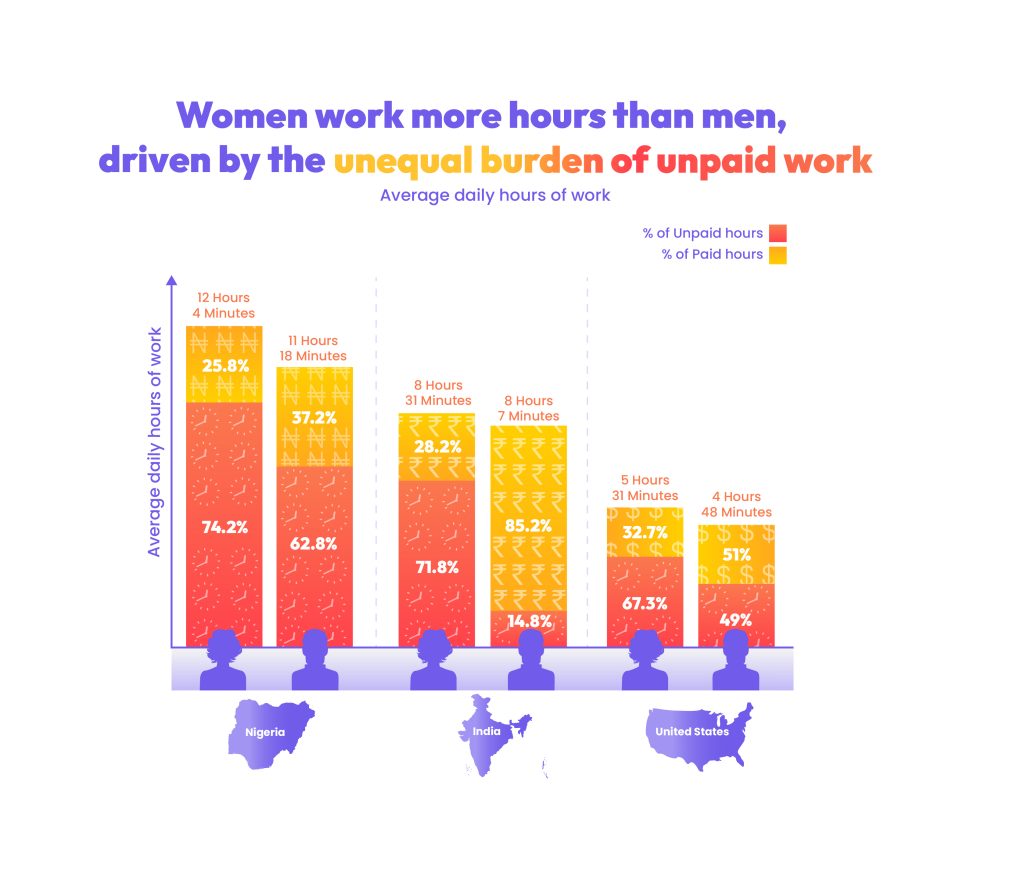
While women have fewer paid working hours than men in all three countries, they work more unpaid hours, ranging from 27 percent more in Nigeria to 500 percent more in India. Because of this unequal share of unpaid labor, women work more total hours than men in all three countries, from 5 percent more in India to 15 percent in the United States. Even worse, this unpaid work is often heat exposed. While women tend to spend less time than men working outdoors, in Nigeria only 4 percent of women’s working hours are in air-conditioned environments. This number jumps to 9 percent in India.
Unpaid domestic labor accounts for between 40 to 70 percent of working hours across the three countries. Surprisingly, previous studies that estimate heat-related labor productivity losses have not taken unpaid labor into account, leading to an incomplete understanding of the full burden of heat’s impacts.
When we factor in unpaid work, women’s heat-related productivity losses increase by 260 percent; men’s losses only increase by 76 percent. When extreme heat strikes, women need to work significantly longer to perform the same volume of paid and unpaid work: from an additional working day per month in the United States; to 90 more minutes per day in India; and 150 additional minutes per day in Nigeria.
Strikingly, over 70 percent of male productivity losses occur in the workplace, whereas up to 75 percent of women’s productivity losses are in unpaid labor across the three countries. These losses—which are not directly accounted for in GDP statistics and fall most heavily on marginalized groups—often go unnoticed by policymakers despite their significant knock-on effects on childcare, family nutrition, and long-term impacts on female education, labor market inclusion, income, and broader economic development.
In unusually hot years, these losses will be even worse. Without action to reduce emissions or adapt to climate impacts, the average daily hours lost to heat are set to increase by 30 percent by 2050. This will be even worse in unusually hot years, defined as a 1-in-40-year event. By 2050, the losses could be 13 to 26 percent worse in those years than the losses in current conditions.
As the heat continues to rise, the time women have to spend on unpaid labor, and women’s “time poverty” will also increase. The excessive burden of work in domestic, household, and unpaid activities will leave little time for paid work and leisure, which can hinder women’s access to the workplace. The unequal division of domestic and care labor must be addressed to close the global gender gap.
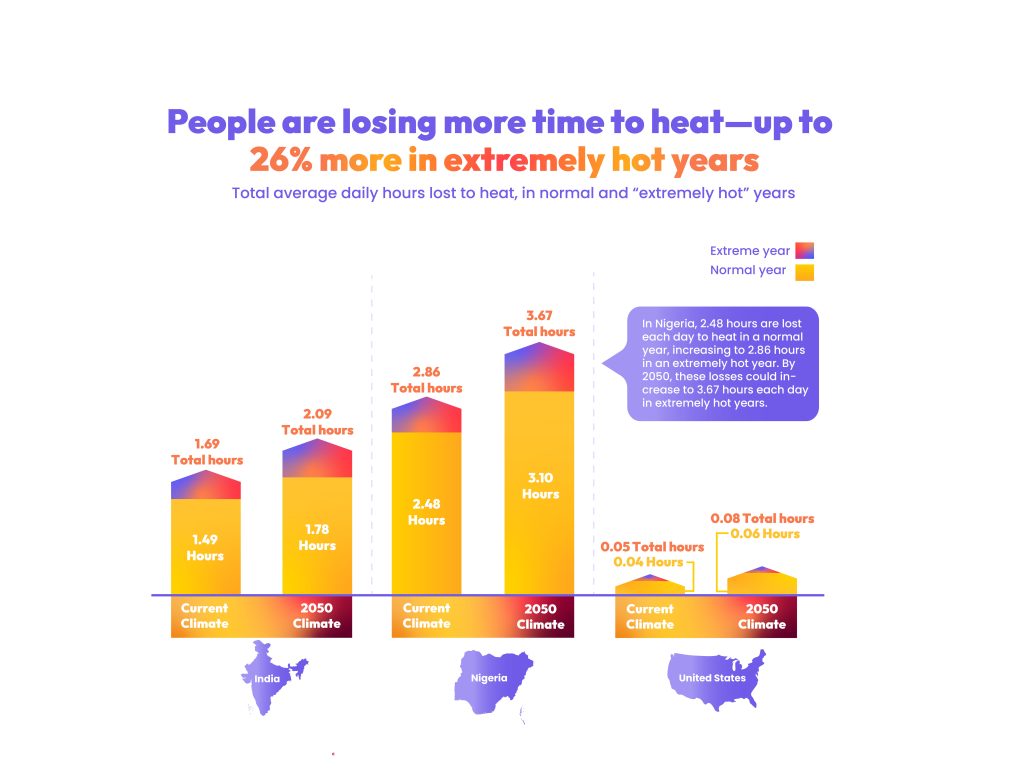
Women bear the cost of climate-driven extreme heat
Heat costs the three countries $120 billion each year in losses to women’s paid labor productivity. The heat-related productivity losses are equivalent to the average woman working eight uncompensated eight-hour shifts each year. While women lose less time to heat for paid labor than for unpaid labor, the impacts are nonetheless significant. In Nigeria, women lose 27 minutes per day under baseline climate conditions, rising to 31 minutes in an extreme year. In India, they lose 41 minutes per day, increasing to 47 minutes in an extreme year. In the United States, they lose 6 minutes per week, rising to 8 minutes per week in an extreme year.
Cumulatively, this represents the time that, in the absence of extreme heat, could be used to earn extra income, acquire additional skills, complete domestic work, or enjoy leisure or rest. The lost productivity has systematic and economy-wide impacts through reduced outputs and lower aggregate incomes. Without action to mitigate or adapt to climate change, time losses in paid work experienced by women are projected to increase by 18 to 44 percent by 2050.
These losses often impact the women least able to bear them. Across the three countries, women in the poorest 40 percent of households lose 40 to 55 percent more paid working hours to heat than those in the wealthiest 40 percent. This is in part because women in poorer households are more likely to work in manual labor or outdoor settings instead of environmentally controlled conditions.
Globally, women earn at least 20 percent less than men. In each of the three countries studied, the gender pay gap is visible in most sectors of the economy, with women earning between 24 to 45 percent less than men. As a consequence, income losses from heat are typically less affordable for women than for men—a fact exacerbated by other structural inequalities such as reduced access to financial services.
Women from marginalized groups are even less resilient to heat-related labor productivity losses. In the United States, for example, Black women are paid 67 cents for every dollar earned by white, non-Hispanic men. For many women, heat may determine whether or not they live in poverty.
In Nigeria, heat-related labor productivity losses are a key reason that average wages have fallen below the minimum wage in the sectors that account for 75 percent of female employment—affecting 22 million women.
BOX 1. The impact of extreme heat on female workers’ wages in Nigeria
There is an economic relationship between labor productivity and wages. In a simplistic model, workers are expected to be paid their marginal product of labor, so that a 10 percent reduction in productivity would lead to a 10 percent reduction in wages. We use this simplistic model to assess what the impact of heat is on average wages for the sector, and what wages could be in the absence of heat. We consider the poverty line monthly income, the wages under current climate conditions, and the projected wages if extreme heat did not impact labor productivity.
In Nigeria, 89 percent of all female employment hours fall under seven sectors. Each of these sectors pays female employees less than the monthly minimum wage. In five of these sectors, including agriculture and manufacturing, losses from heat cause wages to fall below the living wage threshold.
The dual health burden
Heat is already a major global public health risk. By 2050, extreme heat could claim the lives of 204,000 women annually across India, Nigeria, and the United States in hot years. Heat waves can cause exhaustion, heat stroke, cramps, headaches, lethargy, severe dehydration, and blood clots, as well as increased morbidity and mortality. By 2050, heat could pose a similar burden to female health as breast cancer now does in Nigeria (1.8 percent of female deaths), road injuries in India (1.0 percent), and cervical cancer in the United States (0.6 percent).
Due to physiological differences and disparities in access to air conditioning, women face a 1 percent higher risk of heat-related death than men. Further, in extreme years, heat could account for 2.2 percent of total female deaths by 2050.
Heat also has a pronounced impact on maternal and neonatal health. It has been linked to lower birth weights, pre-term births, stillbirths, gestational diabetes, dehydration and endocrine dysfunction, and placental abruption. This is a particularly critical concern in both India and Nigeria where most maternal mortality occurs globally—over 8 percent in India and 28 percent in Nigeria. It could also exacerbate pre-existing racial inequalities in maternal health outcomes in the United States, where Black women are over three times more likely to die from pregnancy-related causes than White women.
Heat creates a double burden for women: they suffer a higher share of the harmful health effects and are still expected to take on a greater share of the resulting care burden. Currently, women already spend between 6 to 10 percent of their time on unpaid care work across the three countries. Additionally, they are also over-represented in paid care work, accounting for between 47 percent (India) and 75 percent (United States) of all hours worked in the health sector.
As the heat rises, people will be more exposed to its dangerous health impacts. Some of the most vulnerable groups—children and people over sixty-five—are often cared for by female family members. Climate-driven extreme heat will increase the need for care inside and outside the formal health care system, and women will shoulder the heaviest burden.
The story of extreme heat in India
Climate change will nearly double the number of heat wave days in India, from fifteen under current climate conditions to thirty by 2050.
As heat increases, it will likewise double the disproportionate heat-related pressures on labor productivity and health that women in India are already experiencing. The abnormally high temperatures—48⁰C (118⁰F) in some cities—pose a threat to economic development in the country. Our analysis suggests that under current climate conditions, 20 percent of outdoor working hours are lost to heat each year and could increase to 24 percent by 2050.
As heat rises, women are especially vulnerable. The country is home to more than one-in-six of the world’s women. These millions of women face significant gender inequality, particularly in labor force participation. At 24 percent, the female labor force participation rate is one of the lowest among developing economies, and almost 50 percent lower than male participation rates. When women are employed, they earn 35 percent less than their male counterparts.
The undervaluation of unpaid work
Women also work an average of 6.1 hours in unpaid labor each day, while men only work an average of 1.2 hours. This profound inequality inhibits economic development. If women were equally represented in India’s formal labor market, the country’s annual GDP could grow by 60 percent by 2025.
For women in India, more than two-thirds of all heat-related productivity losses are from unpaid, domestic labor—an “invisible” dimension of worker productivity that has been largely under-examined and grossly devalued in previous studies. When unpaid labor is accounted for, the data reveals that women lose substantially more total working time than men—almost half an hour a day on average.


This is driven by the time women spend on unpaid work. They spend an average of six hours a day on unpaid work—five times more than men. One of those hours is a direct result of extreme heat in the current climate. In the absence of extreme heat, women would only spend an average of five hours per day. By 2050, without action to reduce emissions or adapt to increased heat, the hours women spend doing unpaid work will increase to 8.3 hours a day. By increasing the time women are obliged to spend on unpaid labor, heat could continue to exclude women from the labor force. It also reduces their time for rest, which contributes to negative outcomes.
Paying the price for extreme heat
Despite their lower labor force participation, the losses to women’s paid labor productivity have significant economic impacts. Women lose 19 percent of their paid working hours to heat, costing the Indian economy 0.8 percent of its GDP or roughly $67 billion annually. By 2050, women are expected to lose 22 percent of their paid working hours, which would cost 1 percent of India’s GDP or $250 billion each year.
In general, women are less able to bear these losses than men. Again, women earn 35 percent less than men on average. Over 80 percent of female employment is in the informal sector, and 75 percent of women are employed in “vulnerable” occupations, which are often excluded from social protection and labor programs. Extreme heat pushes female wages below the poverty line in three sectors, including agriculture, construction, and other service activities, which account for 70 percent of total female employment.
Furthermore, the losses disproportionately affect the poorest women. Those from less affluent households lose 40 percent more paid working hours to heat compared to wealthier women. Among the most affected are low-income women in outdoor and physically demanding occupations, such as brickmakers in West Bengal, who bear the brunt of the impact of heat.
Heat-related losses beyond income
These heat-related losses will impact every aspect of women’s lives: from income to their unpaid, domestic work and their health. Under current climate conditions and with available data, it is estimated that 27,000 women die each year on average due to heat-related excess mortality. In India, this is projected to more than double to 73,500 by 2050. In an extremely hot year, it could rise even further to an unconscionable 131,000 deaths in extremely hot, 1-in-40 probability years. It will account for approximately 1.1 percent of total deaths, surpassing the burden caused by cervical cancer (1.03 percent of female deaths). These estimates are conservative because heat mortality and morbidity data is undercounted—if it is recorded at all.
In addition to the clear mortality risks, rising temperatures will elevate the likelihood of contracting non-communicable diseases such as respiratory diseases, diabetes, hypertension, cardiovascular diseases, declining mental health, as well as other comorbidities that can reduce the quality and length of life, particularly among vulnerable populations.
As their own health worsens, women are also expected to take on the additional care burden for family and community members affected by heat-related illnesses and comorbidities. Women are over-represented in health and social care: they account for 47 percent of healthcare employment and work 78 percent of the total hours dedicated to unpaid care work. Women will be responsible not just for their own health, but for the care of those around them who suffer from the effects of extreme heat.
Unpaid care work is a major factor in determining whether women enter and stay in paid employment, and any increases to this burden caused by climate-driven extreme heat could further exclude women from the labor force.
All across India, women are on the brink of even heavier heat-related losses without an end in sight. Because of the heat, they have lower incomes, more working hours, and exacerbated health risks. When temperatures rise in Ahmedabad, women like Gogiben face an impossible choice: lose their entire income by staying home or put their health at risk by going to work in dangerous heat.
“If there is heat… our goods spoil,” one of the interviewees and a Self-Employed Women’s Association (SEWA) member, Gogi, told us. “Our body also suffers. We get very hot, very dizzy, very distressed.”
Fighting heat with finance: Extreme Heat Income Insurance
In May 2023, Arsht-Rock and the Self-Employed Women’s Association (SEWA), with private sector microinsurance firm Blue Marble Micro, launched the Extreme Heat Income Insurance. The parametric insurance was designed to cover the worst of heat-related losses for women working in India’s informal sector. The beneficiaries of this pilot phase are SEWA members, working in industries ranging from waste recyclers to market vendors. The pilot is paid out when temperature thresholds are met; these payments allow members the flexibility they need to either work more safely or stay home when the heat becomes threatening.
The pilot project also goes beyond the insurance component alone. Through a series of focus group meetings, SEWA members explored how the insurance could better protect them from extreme heat. They identified the tools and resources that could make their work safer. In these discussions, they noted the critical issue of safe food and water storage. In the intense heat, their containers would leech plastic into their drinking water as they heated up and spoil the lunches they brought long before they were ready to eat them. Many could not safely eat or drink throughout the entire workday.
“We did not want to just transfer the risk, as is done in a traditional insurance program. We wanted to also reduce the risk,” said Arsht-Rock Director Kathy Baughman McLeod. As part of the Extreme Heat Income Insurance program and to make SEWA members’ work safer, Arsht-Rock distributed 10,000 water thermoses to SEWA members because of their input in the focus group discussions.
In countries like India, women face systemic barriers that make it more difficult to earn, save, and build a better future for themselves and their children.
“I don’t want my kids to do the work that I am doing. I want my kids to study and get a decent job,” Alpa told us. Alpa works as a waste recycler and is exposed to dangerous heat and fumes throughout her entire workday. She adds, “I really start to cry knowing that my mother also used to work the same way the ladies here are working.”
With solutions like Extreme Heat Income Insurance, women begin to have the tools they need to create a safer, more resilient workplace for themselves and their families.
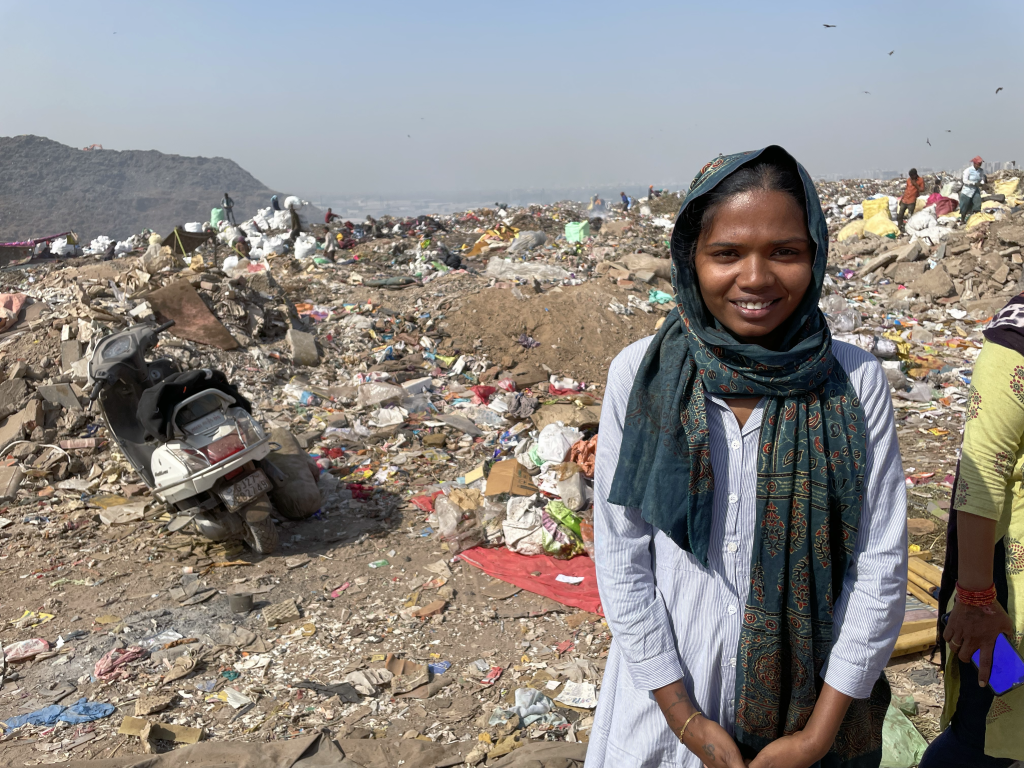
The story of extreme heat in Nigeria
Nigeria ranks 130th out of 146 on the Global Gender Gap Index, which measures gender parity across four categories: economic participation and opportunity, educational attainment, health and survival, and political empowerment.
While the country moved up sixteen places from 2021, the gender gap is still 63.9 percent. One of the factors is the wage gap. While the margin between male and female labor force participation is not wide, women are paid less than men.
These inequalities extend to climate risk. Women are more physically vulnerable to the effects of climate hazards and they are less able to bear the consequences leaving them more exposed to heat’s health and financial impacts. The average number of heat wave days are expected to nearly triple by 2050, which will increase the already disproportionate heat-related pressures on women’s labor productivity.
BOX 2. Projected impact of rising temperatures and heat wave days in Nigeria
This study estimates both shifts in simplified Wet Bulb Globe Temperature (sWBGT), most associated with labor productivity losses, and heat wave days, associated with mortality risk, under current prevailing climate conditions and those that could exist in 2050 without concerted action to reduce emissions.
Under current climate conditions, heat reduces the productivity of outdoor work by 24 percent, which could increase to 30 percent by 2050, while the average number of heat wave days could increase 2.5 times from fifteen per year to thirty-eight by 2050. Southern Nigeria, which is much more densely populated than the north, is projected to see the largest increase in the number of heat wave days, along with a significant rise in year-to-year variability.
Unseen, but not unknown: Heat’s impact on “invisible” labor
In Nigeria, the impacts are often invisible because three-quarters of women’s heat-related productivity losses stem from domestic, unpaid labor. When we account for this “invisible” labor, women lose more working time to heat. Although men spend longer in paid work than women, the additional burden of unpaid work means that women work a full hour extra per day.


This work is often heat-exposed. Nigeria has low rates of domestic air conditioning ownership—28,735 appliances for every one million people—which can increase vulnerability to indoor heat. As a consequence, heat-related labor productivity losses are significant in the home, accounting for 73 percent of all female heat-related labor productivity losses. Women lose 25 percent more time than equivalent losses for men. Women have less time available to spend on other domestic outputs, such as education, self-care, and nutrition; it also reduces their opportunities for more equitable access to paid work. When our study considers unpaid work alongside paid work, women lose 5 percent more total effective working hours than men.
Heat robs women in Nigeria of nearly five hours of paid work each week. These livelihood losses are most concentrated among the poorest households, where women often work in more heat-exposed occupations. These women lose 54 percent more paid working hours than those from wealthier households—putting them at greater risk of being pushed below the poverty line. These five lost hours are equivalent to 22 percent of total hours in paid work.
Nigerian women do not have the same resources as men do to cope with these losses. They earn around 40 percent less than men, are 10 percent more likely to be in vulnerable employment, and are 20 percent more likely to be financially excluded. The effects of heat can be decisive in pushing women below the poverty line. In seven key sectors that account for 75 percent of female employment, losses from heat push the average wages below the poverty line.
These losses do not just impact households. The losses to female labor productivity cost the Nigerian economy 3.5 percent of GDP, equivalent to $37 billion, increasing to $130 billion by 2050.
Heat-health illness, a one-two punch
As global heating raises temperatures, heat’s health-related impacts will further affect women. Heat’s health-related impacts create a double burden for women, as they are both vulnerable to its effects and take on the majority of the resulting care burden.
Heat already accounts for 0.63 percent of deaths in Nigeria under current conditions (17,000 excess heat wave deaths, of which half are women), rising to 1.8 percent by 2050 (67,000 deaths including 32,000 women). By 2050, under current conditions heat will cause more deaths than breast, cervical, ovarian, and lung cancers combined. This analysis likely underestimates the impact as it does not account for the additional vulnerabilities displaced people—including the 1.2 million women and children displaced by civil conflict—face in terms of housing quality and health system access. Heat-related deaths are also undercounted and underrepresented in statistics, meaning even more people could be at risk of heat-related illness and death.
Pregnant women are also especially vulnerable to heat. Nigeria accounts for 20 percent of global maternal deaths—or 58,000 women per year. These numbers will only increase as it gets hotter since pregnant women and their newborns are especially vulnerable to heat-related illnesses.
In addition to their direct health burdens, women are also expected to take on a greater share of the care burden that results. They are already responsible for 55 percent of total time in unpaid care work.
Accelerating local, women-led solutions
For many women, the heat has tangible impacts on their health and livelihoods. In one of Nigeria’s markets, Charity explained the challenges of extreme heat. Sitting in open-air markets, women are exposed to heat, sun, and rain. Their produce and goods spoil in the heat, and when the days become exhaustingly hot the flow of shoppers can slow. The extreme heat has extreme financial and health consequences.
“When the weather is good, I can make up to 10,000 Naira a day. But when there is heat, I hardly make 5,000 Naira,” said Charity. “There was a day I didn’t make any sales because of the heat. I had to pack my things up and leave.”
Asibi shares a strikingly similar story. “There was a particular day that I prepared masa to fry and sell, but because of the heat […] I didn’t sell anything that day because the customers didn’t come and the masa itself was affected by the heat. When it’s too hot, the masa will foam and pour on the ground.”
The heat poses a clear financial and health risk for women like Charity and Asibi. In Freetown, Sierra Leone, Arsht-Rock is working with Mayor Yvonne Aki-Sawyerr and Chief Heat Officer Eugenia Kargbo to co-create solutions with the women directly affected by heat. The Freetown Market Shade Cover Project is part of the Cool Capital Stack, an expanding $800 million investment pipeline that supports and accelerates the local solutions that protect people from the impacts of climate-driven extreme heat. The Market Shade Cover Project directly included the market women in its design, implementation, and governance.
“We need adaptation, not just mitigation,” Kargbo told Bloomberg. Solutions like the market shade covers are simple, scalable solutions that can protect women from the worst of heat and expand their economic opportunities. In a country like Nigeria where women lose 2.5 working hours each day to heat, these solutions are critical to make them physically and financially safer.
The story of extreme heat in the United States
By 2050, the average number of heat wave days will more than double in the United States.
Heat waves are already increasing in frequency, duration, and intensity, as evidenced by the unprecedented 2021 heat dome in the Pacific Northwest that killed 441 people between June 26 to July 3.
The rising temperatures also come with extreme costs. The United States loses $100 billion each year in labor productivity because of heat. Without action to reduce emissions or adapt to climate change, this could increase to $500 billion by 2050. These impacts will be particularly onerous for women, especially those in marginalized communities, who generally face a higher burden of child and family care. However, previous studies on the disproportionate effects of heat on marginalized groups have not sufficiently understood and quantified the gendered aspects of these effects.
BOX 3. Increased exposure to extreme heat during working hours in the United States
This analysis considers both shifts in simplified Wet Bulb Globe Temperature (sWBGT), most associated with labor productivity losses, and heat wave days, associated with mortality risk, under current prevailing climate conditions and those that could be expected in 2050 without concerted action to reduce emissions.
When overlaid with the location of people and economic activity, the analysis finds that people could be exposed to extreme heat during 5 percent of their working hours by 2050 in a normal year, 65 percent more than at present. The number of heat wave days could more than double by 2050 to thirty-three days per year on average. These risks are already concentrated in the eastern and southern United States and will grow most rapidly in these regions.
Much of the existing research on heat-related productivity losses focuses on the workplace. But for women, two-thirds of their losses occur in unpaid, domestic labor where they dedicate almost 150 percent more of their time than men. By ignoring domestic work, these studies underestimate the impact of heat on women. In total, women work almost 0.7 hours per day more than men, driven by the estimated 60 percent more time they spend on unpaid work.
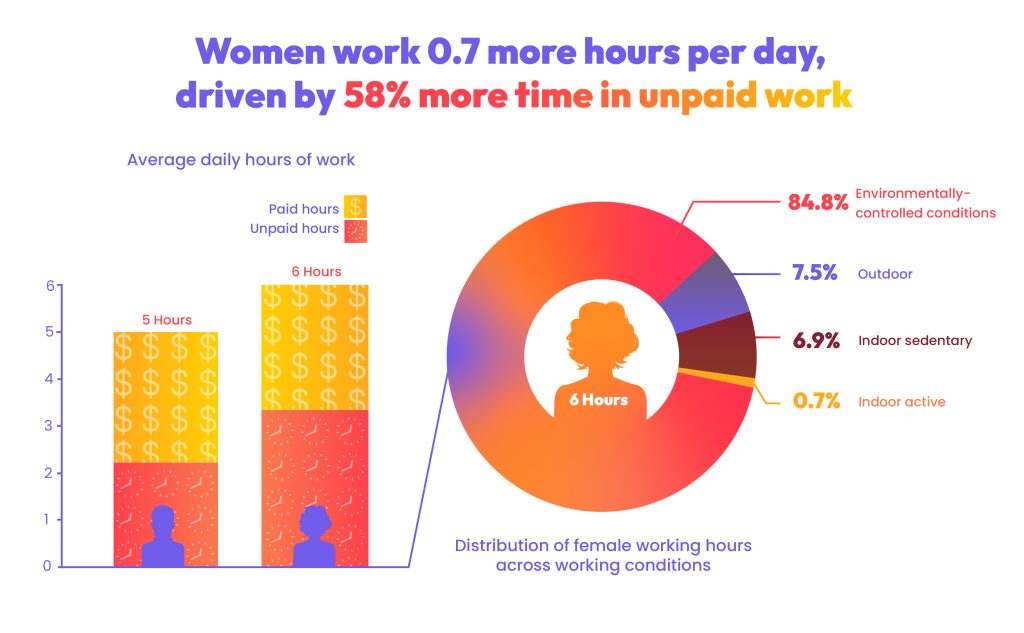
These impacts fall most heavily on those who cannot afford to own or use domestic air conditioning. Meanwhile, national estimates show that domestic air conditioning access for households earning below $20,000 (in 2015, USD) is 8 percentage points below average, which can worsen outcomes for women in particular. As women lose time to their unequal burden of unpaid work, they have less time for other productive investments like paid employment, education, or leisure time.
The vulnerability gap
In the United States, heat-related labor productivity losses exacerbate structural inequalities in earnings between men and women. Women’s earnings are around 24 percent lower than men’s, and women are more likely to live in poorer households. Any negative impact on their income puts them at further risk. The losses are 50 percent higher for women from poorer households than for those in wealthier households. Black women, who are more likely to be employed in lower-paid jobs, face an even higher risk. The loss in female labor productivity in paid work is estimated to cost the US economy 0.08 percent of its GDP, equivalent to $16.8 billion under current climate conditions, rising to $27.7 billion by 2050.
By 2050, nearly 12,000 American women could die from heat during extreme (1-in-40 probability) years. Women are physiologically more vulnerable to the effects of heat. Currently, heat is estimated to cause 2,200 female deaths per year (roughly 0.2 percent of all female deaths), a figure that could rise to 7,400 deaths by 2050 (0.4 percent of all female deaths) or 11,900 in an unusually hot year. These estimates are conservative since heat mortality and morbidity data is undercounted.
Women from marginalized communities are especially vulnerable to extreme heat. Black women, for example, are more than three times more likely to die from pregnancy-related causes than white women, a risk exacerbated by heat. Women will also likely to shoulder the greatest share of the paid and unpaid care load associated with increasing heat-related morbidity. An estimated 75 percent of people employed in the health and social care sector in the United States are women, while 71 percent of total time spent on unpaid care work is done by women. As more people face heat-related illnesses and injuries, women will take on additional—often uncompensated—care work.
Miami’s bringing the heat (action)
As the United States heats up, women need to be better protected and informed of the dangers of heat. In Miami-Dade County, our Chief Heat Officer Jane Gilbert launched a Heat Season campaign to inform county residents of the dangers of climate-driven extreme heat and the ways they can protect themselves. In 2022, the campaign reached an estimated 3.5 million Miami-Dade residents through television and radio promotions. They also reached an estimated 1.07 million residents through outdoor posters and billboards and earned 2.3 million impressions through their social media channels.
The multilingual campaign runs from May 1 through October 31 each year because the city faces “chronic high heat,” says Gilbert. In 2021, Miami had sixty days with temperatures at or above 90°F (32°C) and is projected to have fourty-five days over 95°F (35°C) by mid-century.
As hot days become more common in high-population, concrete-filled cities like Miami, it is urgent to give people the tools they need to understand their vulnerability. A campaign like Miami-Dade’s Heat Season can inform residents of the risks of heat to their health, inform them of the symptoms, and direct them to the city’s resources—like local cooling centers.
Informing and enabling a cooler, more equitable future
From India to Nigeria to the United States, climate-driven extreme heat has become inescapable.
The rising temperatures are punishing, record-breaking, and dangerous, and the intensity of heat and its consequent losses are only projected to increase.
Climate change is clearly worsening gender inequality and left unchecked it can have devastating consequences for households and entire economies. In our study, we uncovered heat’s calamitous impacts on unpaid labor, the “invisible dimension” of worker productivity. Women lose significantly more productive hours to heat than men do, driven by their unequal share of unpaid, domestic work.
Our study only considers a fraction of the ways in which extreme heat can impact gender equality, but it builds understanding around this critical issue. By quantifying the ways heat impacts women’s paid and unpaid labor, we can identify a way forward.
We already know the policies and resources we need to protect people from the impacts of climate-driven extreme heat. There are solutions already implemented in Ahmedabad, Freetown, and Miami-Dade County that are making a difference.
This study shines a light on the path forward. To effectively address climate-driven extreme heat, we must understand the extent of its economic and financial impacts while investing in solutions that confront the urgency of this crisis, and protect people from its scorching effects. When we understand the impacts and invest in gender-informed solutions, we can build toward a cooler, more equitable future—especially for women and girls.
The next steps: Possibilities for future research
This study does not aim to be exhaustive, and there are several areas that could be explored in future research:
- Further analysis into the impacts of heat on marginalized female communities. Women from marginalized communities are expected to be disproportionately impacted by heat.
- More granular subnational research. India, Nigeria, and the United States have diverse, large populations. There are key differences between state and local social protections that could mediate the impact of heat on women, children, and families.
- Additional research on the disproportionate impact of heat on informal workers. Women in India and Nigeria work predominantly in the informal sector, which means that they are excluded from labor and social protections.
- Analysis of the impacts on female morbidity. Women, especially pregnant women, could be negatively impacted months after experiencing a heat event, increasing health risks for themselves and their babies.
- Assessment of the long-term, systemic impacts of heat in perpetuating inequality and inhibiting economic development. This may account for impacts on labor force participation, female education, and poverty reduction.
Methodology
This report was produced by the Atlantic Council’s Adrienne Arsht Rockefeller Foundation Resilience Center with fact-based analysis by Vivid Economics. The conclusions are solely those of the Arsht Rock.
To understand the impact that heat has on women’s unpaid domestic work, paid employment, and health under current and projected 2050 conditions, this report uses the following approach to quantify the gendered differences in heat-related labor productivity losses and mortality impacts. Read the full methodology here.
How we create climate projections:
- We use projections from the Global Climate and Earth System models of the Climate Model Intercomparison Project 6 to analyze current and future (2030 and 2050) climate conditions.
- Utilizing this information, the simple Wet Bulb Globe Temperature (sWBGT) model, and the number of projected heat wave days—the yearly sum of at least two consecutive days with daily mean temperature exceeding the 95th percentile as defined according to current climate conditions—we examine the impact of heat on labor productivity and excess mortality during heat wave days to assess heat-related mortality rates.
- For each warming level, each of the four climate models produces twenty simulated years of data. In this work, we use the statistical distribution provided by the climate model data to calculate the heat wave and heat stress conditions in an ‘average’ year (mean) and an ‘extreme’ year (a 1-in-40 probability of occurrence).
How we established baseline and projected socioeconomic data:
- We compile data on socioeconomic variables including work hours, economic output, and population demographics–and project these forward to 2030 and 2050.
- We estimate socioeconomic variables at the most disaggregated geographical unit for which we could collect data–in India, this was at the district level (where there are 766 districts), in Nigeria at the state level (36 states) and in the US the county level (3,143 counties).
- The variables we include in our analysis include population by age and gender, crude death rates by age, gender, and socioeconomic status, working hours by sector, gender, and occupation, working hours in unpaid work, by gender, gross domestic product by sector, and domestic rates of air conditioning prevalence, by socioeconomic status.
How we measured heat-related paid labor productivity losses:
- Workability functions capture how labor productivity declines as workers are subjected to greater human heat stress. We use existing functions referenced in the literature that relate labor productivity loss to sWBGT and base the time allocation between four types of work environments: outdoors, indoors without air conditioning, indoors sedentary, and indoors with AC.
- Workability functions are assumed to be the same for males and females.
- We calculate heat-related labor productivity losses in paid work in the US using survey data from O*NET, which gives the distribution of working hours spent across different working conditions. As there is no equivalent data for India or Nigeria we use the US O*Net data scores, under the assumption that for a given occupation the proportion of time spent in a specific work environment is the same around the world. However, we adjust the amount of time spent indoors in environmentally controlled conditions based on relevant data that we have on the other two countries.
- We estimate the distribution of working hours spent across different working types by sector and gender using data on the national-level occupational composition of sectors.
How we measured heat-related unpaid labor productivity losses
- Significantly, this report includes the hours people spent doing unpaid labor: household work, primary care work, and secondary child care.
- We utilize time use data is to classify male and female unpaid activities into time spent in the four work ‘types.’
- The indoor portion of time based on the data for region-specific is adjusted based on access to domestic air conditioning.
How we calculated heat-related losses:
- After compiling our findings on the time spent doing paid and unpaid work under different climate conditions, we used a simple economic model following a Cobb-Douglas production to estimate the impact of heat stress experienced by workers on economic production.
Reference our report
Chicago Style Citation: “The Scorching Divide: How Extreme Heat Inflames Gender Inequalities in Health and Income.” Adrienne Arsht-Rockefeller Foundation Resilience Center, July 26, 2023. https://onebillionresilient.org/extreme-heat-inflames-gender-inequalities/.
APA Citation: Adrienne Arsht-Rockefeller Foundation Resilience Center. (2023, July 26). The scorching divide: How extreme heat inflames gender inequalities in health and income. https://onebillionresilient.org/extreme-heat-inflames-gender-inequalities/
Acknowledgments
A report like this is not possible without the collaboration of many trusted partners and individuals.
We would first like to thank the women who shared their stories with the Arsht-Rock team and our partners on the ground in India, Nigeria, and the United States. Their stories help us understand the very human impact of climate-driven extreme heat. These interviews inform the nature of this report and are essential to its impact. To respect the privacy of the women we interviewed, and in accordance with their preferences, we have used only their first names throughout the report.
Thank you to the partners that helped us identify the interviewees, including the Self-Employed Women’s Association in India; Pathfinder in Nigeria; and WeCount in the United States.
We would also like to acknowledge the creative teams that brought this report to life. Thank you to the videographers and photographers for their contributions, especially Femi Bamigbola and his team at Four Seasons Media in Nigeria who edited the video content for this report. We also appreciate the work of our partners at Shape History for their work on designing the visualizations.
As ever, we are deeply grateful to our founder and inspiration Adrienne Arsht and to the Rockefeller Foundation for their unwavering support of our work.
To all our supporting partners who made this report possible, thank you!


